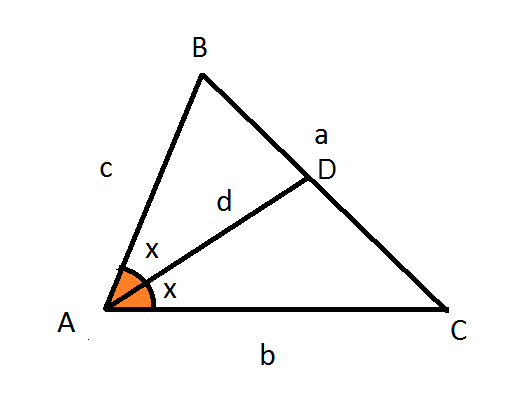Scalene triangles and angle bisectors
In a triangle A B C , A D is the internal angle bisector of ∠ A .

The sides a , b and c are 6, 5 and 4 units respectively. If d = n m , where m and n are coprime positive integers. Then find m + n .
The answer is 13.
This section requires Javascript.
You are seeing this because something didn't load right. We suggest you, (a) try
refreshing the page, (b) enabling javascript if it is disabled on your browser and,
finally, (c)
loading the
non-javascript version of this page
. We're sorry about the hassle.
2 solutions
What is that formula called? never seen it before. Would be quite interested to see the derivation
Angle Bisector Length that is obtained by using Stewart's Theorem --- https://en.wikipedia.org/wiki/Stewart%27s_theorem. Let BD=m & DC=n. Then by the Angle Bisector Theorem: m=ac/(b+c) and n=ab/(b+c). Now we apply Stewart's Theorem to get: mb²+nc²=a(mn+AD²) which yields: a(AD²) = mb²+nc²- amn or AD²=(m/a)b²+(n/a)c²-mn=cb²/b+c)+bc² -a³bc/(b+c)²=bc[b/(b+c)+c/(b+c)-a²/(b+c)²]=bc[b(b+c)+c(b+c)-a²]/(b+c)²=bc[b²+2bc+c² -a²]/(b+c)²= bc[1-a²/(b+c)²]
By cosine rule , we have:
a 2 6 2 ⟹ cos 2 x sin 2 x cos 2 x ⟹ cos x sin x = b 2 + c 2 − 2 b c cos ∠ A = 5 2 + 4 2 − 2 ( 5 ) ( 4 ) cos 2 x = 4 0 1 6 + 2 5 − 3 6 = 8 1 = 1 − cos 2 2 x = 1 − 8 2 1 = 8 3 7 = 2 cos 2 x − 1 = 8 1 = 1 6 9 = 4 3 = 1 − cos 2 x = 1 − ( 4 3 ) 2 = 4 7
The area of △ A B C are given by:
[ A B C ] = 2 1 b c sin ∠ A = 2 1 ( 5 ) ( 4 ) sin 2 x = 4 1 5 7
The area is also given by:
[ A B C ] ⟹ 4 1 5 7 ⟹ d = 2 1 b d sin x + 2 1 c d sin x = 8 9 7 d = 3 1 0
⟹ m + n = 1 0 + 3 = 1 3
d² = bc[1-a²/(b+c)²]= 4x5(1-6²/9²) ► d =10/3 units.